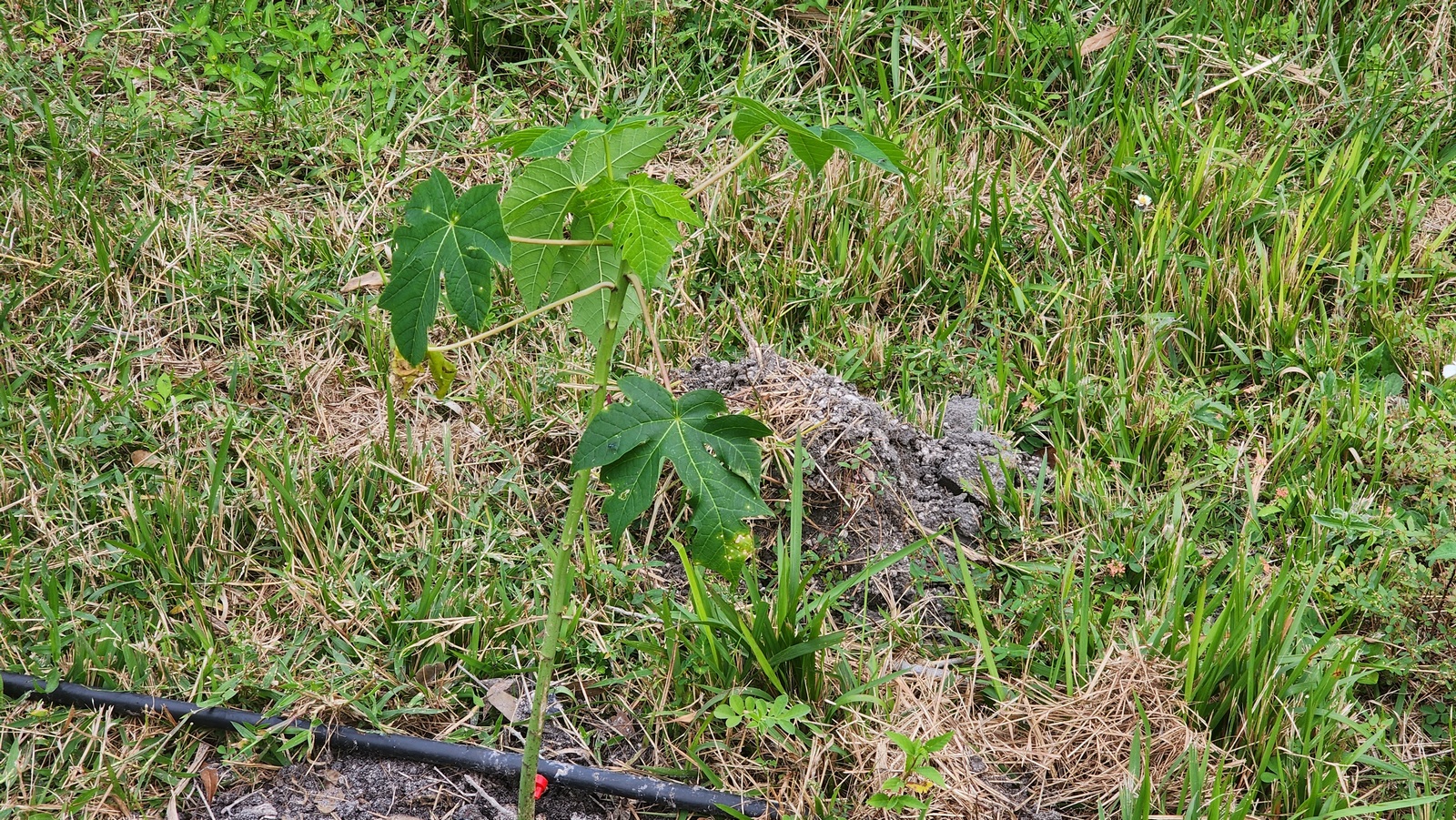Growing Instruction
CARE OF PAPAYA PLANTS IN THE HOME LANDSCAPE
A calendar outlining the month-to-month cultural practices for papaya is shown in Table 1.
FERTILIZER
Frequent applications of small amounts of fertilizer are best for continuous papaya growth and fruit production (Table 2). Young plants should be fertilized every 14 days with 1/4 lb of a complete fertilizer with the amounts increasing as trees become larger. Complete fertilizers include nitrogen (N), phosphate (P2O5), potash (K2O), and a source of magnesium (Mg). Once trees become about 7 to 8 months old they should be fertilized with 1 to 2 lbs every other month. Minor elements may be applied up to 1 time per month. Minor elements including manganese and zinc may be applied to the ground in soils with a low pH (7 or less) and foliarly applied for plants growing in high pH soils (>pH 7). Similarly, iron sulfate may be applied to the ground for plants growing in low pH soils. However, for plants growing in high pH soils, chelated iron (an EDDHA form) should be mixed in water and applied as a soil drench.
IRRIGATION (WATERING)
Watering is essential for best papaya plant growth and fruit production. Papaya plants that lack water (drought stress) may drop flowers, leaves, and young fruit and produce small fruit of low sugar content.
Plants growing in sandy or rocky soils that are well drained and do not hold much water should be watered every other day or every day during hot, dry conditions and less often during cool parts of the year (late fall, winter). Plants growing in soil with a capacity to hold water (loams, sandy loams) should not be overwatered and therefore should be watered at 3- to 4-day intervals, especially during hot weather.
MULCH
Mulching papaya trees in the home landscape helps retain soil moisture, reduces weed problems adjacent to the tree trunk, and improves the soil near the surface. Mulch with a 2- to 6-inch (5- to 15-cm) layer of bark, wood chips, or similar mulch material. Keep mulch 8–12 inches (20–30 cm) from the trunk.
INSECT PESTS AND NEMATODES
Papaya plants are attacked by a number of insect pests including:
The papaya fruit fly (Toxotrypana curvicauda), which lays eggs through the papaya fruit peel into the fruit cavity where the larvae feed and eventually emerge from the ruined fruit. This fly is commonly mistaken for a wasp due to its long abdomen and yellow and black markings. Fruit infested with papaya fruit fly may show yellow areas and may drop from the tree prematurely. The easiest control for this pest is to place a paper bag or paint strainer cloth over individual fruit when they are small and leave the bag on until harvest.
The papaya webworm (Homolapalpia dalera) is mainly a pest of the developing fruit peel and papaya stem and is usually found in, on, or near the stem amongst the flowers and fruit. Control includes hand removal and hosing off the plant with a strong stream of water from a garden hose.
The papaya whitefly (Trialeuroides variabilis) is generally only a pest of the leaves, causing leaves to drop and reducing fruit production. Control includes removing infested leaves and applying appropriate pest control products.
The two-spotted mite (Tetranychus urticae) is a major pest of papaya leaves and may cause defoliation and early leaf drop. Symptoms include browning of the leaf surface and eventually upper leaf surfaces and skeletonizing of the leaf. For current control measures please contact your local UF/IFAS Extension agent.
A number of nematode species (Meloidogyne incognita, Rotylenchulus reniformis). Nematodes are small, microscopic, worm-like organisms that feed on papaya plant roots, causing plants to decline in vigor and making more plants more susceptible to toppling over because of the loss of roots. Papaya plants should be planted in areas with clean soil, avoiding areas of the landscape with known nematode problems.
DISEASES
Papaya plants in Florida are susceptible to a number of diseases:
Papaya ringspot virus is the most important disease of papaya in Florida. The earliest symptoms are a yellow mottling of leaves and vein-clearing of leaves. As the disease progresses, the lobes of the leaves become distorted and leaf size is greatly reduced. Dark green streaks may develop on leaf petioles and the main stem. Fruit symptoms consist of dark circles or C-shaped markings on the fruit peel. Homeowners wishing to grow papaya in their home landscapes should avoid using seeds from small, pear-shaped Solo-type fruit, which tends to be more susceptible to this virus than the larger, elongated, oval-shaped fruit found in many local markets. All papaya plants showing symptoms of the virus should be removed so as not to be a source of infection for new plants. Due to the problems with this virus, we recommend replanting papaya plants every 18 to 24 months.
Anthracnose (Colletotrichum gloeosporiodes) primarily attacks the maturing fruit. Symptoms include small water-soaked spots that enlarge, turn brown or black, and become sunken. Eventually, the fungus grows into the fruit tissue, ruining it for consumption. Please contact your local UF/IFAS Extension agent for current control recommendations.
Powdery mildew (Oidium caricae) is primarily a disease of the leaves in Florida. A superficial white growth on the leaf surfaces leads to small, light yellow spots on the lower surfaces of the leaves. Next, pale yellow spots appear on the upper leaf surfaces. Eventually, dead leaf areas fall out of the leaves, giving them a shot-hole effect. Control includes removing infested leaves and removing them from near the plants.
Phytophthora blight (Phytophthora spp.) includes a number of diseases including damping-off, root rot, stem rot, and fruit rot. These diseases decrease plant vigor and may result in plant death. Starting new plants in clean (not previously used) potting media will help avoid root rots.
Corynespora leaf spot (Corynespora cassiicola) is a disease of the leaves and begins as small, yellow areas which expand into larger (0.2–0.4 inches) circular brown spots.





Comments